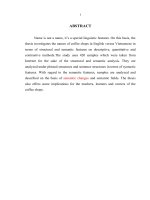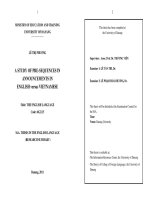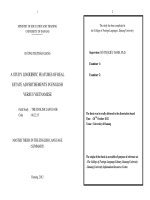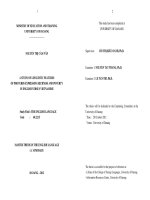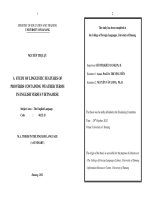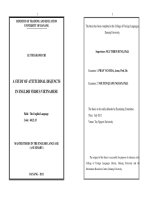A study of rhetorical devices in titles of online tourism newspapers in english versus vietnamese
Bạn đang xem bản rút gọn của tài liệu. Xem và tải ngay bản đầy đủ của tài liệu tại đây (546.84 KB, 26 trang )
THE UNIVERSITY OF DANANG
UNIVERSITY OF FOREIGN LANGUAGE STUDIES
PHẠM THỊ PHƯƠNG ANH
A STUDY OF RHETORICAL DEVICES
IN TITLES OF ONLINE TOURISM NEWSPAPERS
IN ENGLISH VERSUS VIETNAMESE
Major: ENGLISH LINGUISTICS
Code: 822 02 01
MASTER THESIS IN
LINGUISTICS AND CULTURAL STUDIES
OF FOREIGN COUNTRIES
(A SUMMARY)
Da Nang, 2020
This thesis has been completed at University of Foreign Language Studies,
The University of Da Nang
Supervisor: Assoc. Prof. Dr. Nguyễn Thị Quỳnh Hoa
Examiner 1: Assoc. Prof. Dr. Nguyễn Văn Long
Examiner 2: Dr. Bảo Khâm
The thesis was orally defended at the Examining Committee
Time: July 3rd 2020
Venue: University of Foreign Language Studies -The University
of Da Nang
This thesis is available for the purpose of reference at:
- Library of University of Foreign Language Studies, The
University of Da Nang.
- The Center for Learning Information Resources and
Communication - The University of Da Nang.
1
Chapter One
INTRODUCTION
1.1. RATIONALE
Newspaper nowadays is an indispensable part of human’s
lives by providing a huge amount of information such as facts,
stories, statistics, and reports about various areas of life. Since
tourism proves its typical role in the socio-cultural integration of a
country together with economic development, tourism newspapers
become more and more popular. Tourism is also a gold opportunity
to spread the local and domestic culture, traditions and values. The
rapid development of science and technology in recent years has led
to the creation of online tourism newspaper that has become a
breakthrough with the great benefits it brings to the tourism industry
in not only advertising effectiveness but also time and cost saving.
Practically, reading newspapers in foreign language is pretty
difficult to fully understand all the writers’ implication. Structures
and expressions in English articles often make Vietnamese readers
confused. By that reason, English online tourism newspapers
accompanied with different rhetorical devices make it hard for
Vietnamese readers to catch the meaning of the text.
Meanwhile, the title is considered to be one of the most
important parts of newspaper article. A bad, unattractive or
inappropriate title may make readers pass the news and ruin the
effort of the writer. Using rhetorical devices in the titles, journalists
can attract and catch the eyes of readers by drawing vivid pictures for
the readers to visualize and evoke their positive emotions from the
first moments. In terms of language and linguistic functions,
rhetorical devices prove their effects in expressing the author’s ideas
and intention. Rhetorical devices are widely employed strategies in a
2
wide range of fields such as arts, literature, communication,
presentation and daily life. Studies about rhetorical devices or
stylistic devices have been done by many researchers and linguists
but in different aspects. Following is an example of a title in
Vietnamese online tourism newspaper:
“Mơ màng Suối Yến”
The writer use personification (words used for human-being
are applied to illustrate things/ objects) to describe the beauty of
“Suối Yến/Yen Stream”. The noun “mơ/dream” ¬_ a series of
thoughts, images, and sensations occurring in a person's mind during
sleep, is the root adjective “mơ màng/dreaming” used to describe
Yen Stream instead of a person. It sketches a fanciful and beautiful
scene which is rare and incredible like a dream. By questioning what
the dreaming thing appears in that Yen Stream, readers might click
on and continue reading to finally realize the miracle attraction is not
only in the beauty of the stream but also underneath the mystery
stories that people keep telling about Yen Stream. Consequently, the
use of personification (one of rhetorical devices) in this title might
have potential effective on motivating tourists to spend time
exploring more and help develop tourism behavior.
All of these motivate me to conduct the research “A STUDY
OF RHETORICAL DEVICES IN TITLES OF ONLINE TOURISM
NEWSPAPERS IN ENGLISH VERSUS VIETNAMESE”.
1.2. AIMS AND OBJECTIVES OF THE STUDY
1.2.1. Aims of the study
This study is aimed to:
- - Investigate into the effectiveness of rhetorical devices in
titles of online tourism newspapers in English and Vietnamese.
1.2.2. Objectives of the study
3
This study is intended to:
- Find out and describe common rhetorical devices used in
titles of online tourism newspapers in English and Vietnamese
- Explore the similarities and differences between common
rhetorical devices used in titles of online tourism newspapers in
English and Vietnamese
1.3. RESEARCH QUESTIONS
In order to achieve the above aims and objectives, the
following research questions are put forward:
1. What rhetorical devices are used in titles of online
tourism newspapers in English?
2. What rhetorical devices are used in titles of online
tourism newspapers in Vietnamese?
3. What are the similarities and differences in rhetorical
devices used in the English and Vietnamese titles of online tourism
newspapers?
1.4. SCOPE OF THE STUDY
This study focused on the rhetorical devices used in English
and Vietnamese titles of one American and one Vietnamese online
tourism newspaper in the period 2018-2019. This thesis was carried
out and based on 200 English titles from Travel Daily News and 200
Vietnamese titles from Du Lich. Travel Daily News and Du Lich are
two popular online tourism newspapers in English and Vietnamese.
The aspects of tourism mentioned in those articles vary from food,
destinations to activities, travel experience, hotel and lodging, mice
industry, aviation, sea travel and so on.
1.5. SIGNIFICANCE OF THE STUDY
This thesis may help English learners and teachers in Vietnam
have better insight into the rhetorical devices used in titles of online
4
tourism newspapers in English and Vietnamese. It is hoped that, the
data and contrastive analysis of this research will be worth reading
for the readers who take interest in reading English and Vietnamese
online tourism newspapers.
1.6. ORGANIZATION OF THE STUDY
There are five main chapters in this study as follows:
- Chapter 1: Introduction - includes the rationale, aims and
objectives, the research questions, the scope of the study, the
significance of the study and the organization of the study.
- Chapter 2: Literature Review and Theoretical
Background - presents the previous studies which are closely related
to the thesis and the theoretical background of the study.
- Chapter 3: Research Methods - describes the research
design, the research methods, the data collection, samples,
instrument, procedure of the study, the data analysis and the
reliability and validity of the study.
- Chapter 4: Findings and Discussion – aims at describing,
comparing to find out the similarities and differences in the rhetorical
devices using in the titles of English and Vietnamese newspapers.
- Chapter 5: Conclusion and Implications - gives the
summary of what has been drawn out from the study and some
implications. This section will also give some suggestions for further
research.
Chapter Two
LITERATURE REVIEW AND THEORETICAL
BACKGROUND
2.1. LITERATURE REVIEWS
2.2. THEORETICAL BACKGROUND
5
2.2.1. Definition of Online Tourism Newspaper
“Short” and “catching” are words describing the features of
English titles (Bastian et al., 1956, p.62). The significances of the
news are packed in some key words in the titles and a good title will
not only convey the brief content of the articles but also catchy
enough to arouse reader's curiosity. In some English newspapers
sensational titles are quite common. The practices of title writing are
different with different newspapers. The selection of language is
based on the peculiar nature and expression meaning of the titles
(Galperin, 1977, p.303).
2.2.2 Definition and features of titles of online tourism
newspapers
In general, the titles of online tourism newspapers are the
headings of the news which contains the most important and
interesting information of the articles. They are often short and
catching in order to catch readers’ most attention and also help them
to have a quick, accurate and comprehensive visualization of the
news.
2.2.3. Definition of Rhetorical Device
Rhetoric has raised a great deal of awareness among many
linguists and researchers in the world for so long. Richard (1973,
p.160) defines it as "the art of linguistically or symbolically creating
salience. After salience is created, the situation must be translated
into meaning”. Farrell (1993) claims that “rhetoric is an acquired
competency, a manner of thinking that invents possibilities for
persuasion, conviction, action, and judgments." This paper will
mainly mention the studies of Galperin (1977) and Đinh Trọng Lạc
(2003) two famous linguists who had well-known accredited
researches about RDs as the theoretical background. Basing on the
6
use of rhetoric in language, Galperin defines each RDs as a
generalized model of applying extra certain structures or semantic
property in basic structure sentences with specific purposes In the
book “99 phương tiện và biện pháp tu từ tiếng Việt” by Đinh Trọng
Lạc, RDs in Vietnamese is defined as means of language which
usually bring additional information apart from the basic meaning of
words. It can be seen that the theory of Galperin emphasizes more on
the key function of RDs which will be explained more following. In
short, rhetorical devices in language can be understood as language
tools added to a sentence under authors’ purposes which creates
special effects in linguistic expression.
2.2.4. Functions of Rhetorical Devices
According to Galperin (1977), RDs are used as language tools
with 2 main functions. For the sake of the readers, RDs make the
objectives of the writers clearer to the readers so that they can
understand the emotions, feelings, and ideas of the writer at a deeper
level. About the writers, RDs convey their messages and
perspectives more vividly to evoke readers’ responses under the
writers’ purposes. Generally, RDs create a system of signs used to
evoke emotion in readers and influence their decisions and actions.
For this reason, RDs used in online tourism newspapers might have
their goal to add special effects on the advertisements which will
appeal to the potential audience and finally influence human choices
on specific travel decisions and bring benefits to the industry.
2.2.5. Classification of Rhetorical Devices
The classification suggested by Galperin (1977) is simply
organized and very detailed. He classify RDs into three types based on the
level-oriented approach, they are phonetic, lexical and syntactical RDs.
2.2.5.1. Phonetic Rhetorical Devices
7
a. Onomatopoeia
b. Alliteration
c. Rhyme
2.2.5.2. Lexical Rhetorical Devices
a. Metonymy
b. Metaphor
c. Personification
d. Simile
e. Irony
f. Hyperbole
g. Allusion
2.2.5.3. Syntactical Rhetorical Devices
a. Stylistic Inversion
b. Rhetorical Questions
c. Enumeration
2.6. SUMMARY
Rhetorical devices, their charateristics and functions have
attracted attention of many linguists as well as researchers. The
matter of discovery of theirl marvel as weel as application them in
literature is always new and endless. RD is certainly an important
instrument which can help language users transfer their message
fully and meaningfully, reach their aims in communication.
Although the title plays an important role in the effectiveness
of an online tourism newspaper, the RDs used in those are not
always the same in all articles or in the two languages. But their
similar influence on news’ success and reader’s feeling and reaction
can not be refused. This thesis hopes to partly contribute to analyzing
and understanding more about the RDs used in TOTNs, their
importance and their impact on readers.
8
Chapter Three
RESEARCH METHODS
3.1 RESEARCH DESIGN
This thesis is aimed at investigating common RDs used in
the titles of online tourism newspapers in English and Vietnamese.
This is both a qualitative and quantitative study. The design has been
made with the aim of exploring and finding the features of some
commonly used RDs together with the similarities and differences in
English and Vietnamese TOTNs.
3.2. RESEARCH METHODS
This study was carried out via the descriptive method and the
contrastive.
The descriptive method was used in the first step to describe,
characterize the RDs used in the titles and classify them into
different categories.
The contrastive method was used to find out the similarities
and differences of some common RDs in English and Vietnamese
TOTNs.
3.3. DATA COLLECTION
This study focuses on the rhetorical devices used in English
and Vietnamese titles of one American and one Vietnamese online
tourism newspaper in 2018-2019. The sources for this study were
chosen based on Google Top Results. Travel Daily News (
was the first result with the key
words “the most popular Online Tourism Newspapers”. Although
Du Lich ( was the third result with the key words
“Các trang báo mạng du lịch Việt Nam”, it was selected to study
because of its domain (.org) and the internationality with both
English and Vietnamese articles. This thesis was carried out and
9
based on 200 English titles from Travel Daily News (
and 200 Vietnamese titles from
Du Lich ( Travel Daily News and Du Lich are two
popular online tourism newspapers in English and Vietnamese. The
aspects of tourism mentioned in those articles vary from food,
destinations to activities, travel experience, hotel and lodging, mice
industry, aviation, sea travel and so on. The criteria for choosing
samples are:
- The samples must be a language expression displaying a
specific rhetorical device as defined in Chapter 2.
- The sample must be part of a title of one of the online
tourism newspapers mentioned in the scope of the thesis.
3.5 DATA ANALYSIS
Each TOTN was analysed by qualitative method. RDs used
in English and Vietnamese are classified and categorized in
accordance with particular types of RDs. The collected samples were
qualitatively categorized and tabulated in accordance with particular
types of RDs as earlier stated.
Linguistic description and analysis helped to analyze each
group in detail to clarify its own characteristics.
Finally, the data were compared and contrasted to make the
conclusion of the similarities and differences in terms of RDs in
English and Vietnamese TOTNs.
3.5. RESEARCH PROCEDURE
The procedure of this study followed these steps:
- Reading carefully the previous studies to choose the topic.
- Orientating the problems relating to the thesis.
- Reviewing the previous studies thoroughly and identifying
the research scope.
10
- Collecting and classifying of 200 English titles and 200
Vietnamese titles of tourism articles from two travel sites of America
and Vietnam.
- Analyzing data: point out the artistic, aesthetic and
expressive value of each rhetorical device and their contributions to
the success of the titles.
- Contrastive analysis for analyzing the data in quantity and
quality; similarities and differences of some commonly used RDs in
English and Vietnamese titles.
- Putting forward some implications on practical application
or further.
3.6. RELIABILITY AND VALIDITY
Firstly, the titles used for analysis were taken from reliable
sources which were the two official online tourism newspapers in
English and Vietnamese. All quotations in this thesis were cited
exactly from the origin with clear reference of the authors’ names,
the time, the place of publication and even the page number.
Secondly, the findings and conclusions in the study were
drawn from the process of collecting, classifying, analyzing and
comparing the data without any prejudices and presuppositions.
Finally, the analyses in this study were conducted following
the Theoretical framework mentioned in Chapter Two to make a
consistent and rational study. By all these reasons, this research study
and its result were reliable.
3.7. SUMMARY
In general, in this study, the constrative analysis was
intended to follow qualitative and quantitative approaches. After the
data collection, the observation and analysis of titles of online
tourism newspapers in English and Vietnamese were proceeded so
11
that the similarities and differences in the use of rhetorical devices in
both languages could be drawn out.
Chapter Four
FINDINGS AND DISCUSSION
4.1. PHONETIC RHETORICAL DEVICES IN ENGLISH AND
VIETNAMESE IN ENGLISH AND VIETNAMESE ONLINE
TOURISM NEWSPAPERS’ TITLES
4.1.1. Alliteration
The repeating of sounds or letters in the titles might not refer
to any meaning but it is a good way to make impression to readers’
mind, consider some examples following:
In English:,
(4.1) Accessible aviation: Galloping growth
( />(4.2) Revolution at the Royal: “Golf is not enough”
( />(4.3) IGTM 2019 unveils headline speakers to “Grow golf
together” in Marrakech
( /> In Vietnamese: There is no sample using alliteration in the
data collection.
4.1.2. Rhyme
In English:
(4.4) 9th Athens Open Air Film Festival - Magical cinema
nights [naɪt] under Attica’s starry sky [skai].
( />
12
In Vietnamese: There is no sample using rhyme in the data
collection.
4.2. LEXICAL RHETORICAL DEVICES IN ENGLISH AND
VIETNAMESE IN ENGLISH AND VIETNAMESE ONLINE
TOURISM NEWSPAPERS’ TITLES
4.2.1. Metonymy
In English: Let examine these titles taken from the data
collection:
(4.5) Travel industry discusses approaches to manage
sustainable tourism growth in Europe
(ope)
Travel industry is used in this titles to refer to people who
work in it and attend the conference about sustainable tourism
growth in Europe. Instead of listing all the participants’ career
positions and fields, the writer use this metonymy image to
emphasize the importance of the issue not only to individuals or
some organizations but more to everyone works in this industry.
In Vietnamese
(4.6) Cao Bằng: Làng đá Khuổi Ky làm du lịch homestay.
(Cao Bang: Stone Village Khuoi Ky develops homestay tourism.)
(...30490)
(4.7) Làng Bao La làm du lịch, đưa tre Việt đi ra thế giới.
(Bao La Village develops tourism, brings Vietnamese bamboo to the
world.)
(...28053)
Làng đá Khuổi Ky and Làng Bao La are both geographic
locations in Vietnam. They both refer to the citizens living there who
decide to invest on local tourism development to let more and more
13
people notice their hometown. Metonymy in this case has the effect
of creating a concrete and vivid image of ordinary local citizens.
4.2.2. Metaphor
Metaphor is used in online tourism newspapers in English and
Vietnamese with the purpose of stimulating the curiosity and
attracting the attention from readers by breaking the primary
meaning of metaphor words in particular contexts like following
examples:
In English:
(4.8) Azamara sets sail with PerryGolf for more than 70
Marquee golf courses in over 20 countries.
(ship)
This is a metaphoric title that emphasizes the fact of taking
partnership and cooperating of Azamara and PerryGolf by the
phrase sets sail.
(4.9) Traveling fans head to Japan for Rugby World Cup
2019.
(..2019)
Similarly, in sample 4.10, head (n) is a part of human body
which decides the thoughts and mind of a person, when someone
takes notice a thing, his head also turns into the thing’s direction. The
writer wants to imply in this title the lively image that traveling fans
are feeling interested in and traveling to Japan in order to attend the
Rugby World Cup 2019.
In Vietnamese
(4.10)Báo Hongkong ấn tượng năm tầng thượng phô diễn
"hào quang" của Sài Gòn.
(Hongkong Newspaper is impressed by five rooftops showing
the “halo” of Saigon.)
14
(...28696)
Hào quang/ halo does not only refer to the circle of light that
human eyes can see. Hào quang becomes a concept of the dynamic
bustle of Saigon especially at night. Consequently, readers can
imagine a picture of brilliant Sai Gon by nights.
4.2.3. Personification
In English: There is no English titles in the data collection
using personification.
In Vietnamese
The objects become more lively and attractive with human’s
feelings, characteristics or actions. In order to bring human life to
these inanimate objects, writers choose verbs or adjectives which
normally belong to human beings. Vietnamese titles uses
personification four times more than English ones, and the numbers
of verbs employed is also much higher than adjectives. 10/12
personification cases in Vietnamese titles use verb as a means to
characterize things and objects. Let us take a closer look at the
following instance:
(4.11) Gia Lai trở mình vào mùa đẹp nhất trong năm. (The
weather of Gia Lai turns over in the most beautiful season of year).
( />The verb trở mình gives Gia Lai_ a destination in Vietnam
ability to act like a lady. Naturally, when seasons change, the scenery
in a place also changes which makes interesting differences in
different time of a year and creates curiosity among tourists. When a
person is lying in a position for a while, they will trở mình (turn
over) to change the position and feel more comfortable. This verb
brings the imagination in the readers' mind about the magic of a land
that suddenly changes completely right after changing season and
15
provokes viewers' curiosity to find out when the season is and how
the change happens.
(4.12)Đi đâu thì đi nhưng đừng quên Tây Bắc mùa xuân, hoa
đang gọi.
(Wherever you go, don’t forget Taybac in spring, the flowers
are calling you).
( />The hoa (flower) is the attractive characteristics of Tây Bắc
land, it appears like people living there, are smiling at the guests and
waving to visitors to their localities. Thanks to this, Tây Bắc land
appears as a welcoming and hospitable land. Other cases also use the
verbs related to engaging or attracting other people such as vẫy gọi/
beckon, đón/ welcome, gọi/ call, níu/ hold, hút/ attract, mê hoặc/
glamour.
Other two remaining cases are:
(4.13)Mơ màng Suối Yến.( Dreaming Yen Stream)
(...30542)
(4.14)Nghệ An: E ấp biển Quỳnh.(Nghe An: Bashful Quynh)
(...29684)
Each adjective above describes different human’ feeling, mơ
màng/ dreaming is the beauty and unique charm of Suối Yến, e ấp/
shy, bashful depicts the sight of unspoiled and pristine beaches, like
a beautiful country girl who still feels shy and timid to be seen by
outsiders.
4.2.4. Simile
Using simile in the titles, the authors can help readers to
visualize more easily and specifically what they want to mention. Let
consider following samples:
16
In English:
(4.15) Luxuria is your key to the world of extraordinary
lifestyle experiences.
( />Luxuria is compared to the key which is an indispensable
item, the writer emphasizes the importance of Luxuria for travelers
in order to get to the world of extraordinary lifestyle experiences. In
this sample, the verb is can be regarded as to comparing word
between two objects.
In Vietnamese
(4.16)Pù Luông - Thiên đường giữa đại ngàn (Pu Luong –
The heaven in the Jungle)
(...29830)
(4.17)Ghé thăm hồ Lắk – viên ngọc giữa đại ngàn Tây
Nguyên (Visit Lak Lake- The jewel in Tay Nguyen jungle)
( />The subjects in these titles are compared to other things basing
on some similar characteristics. Thiên đường/ heaven is the place of
angels and all the best things in life happen. The author use thiên
đường for Pù Luông with an implication of beautiful natural
scenery as well as comfortable experiences that tourists may have
when coming there. Viên ngọc/ the jewel is not only beautiful but
rare and valuable, that is the reason it is used to compared to the Lak
Lake in order to praise the beauty of that lake. Using simile in the
titles, the authors can help readers to visualize more easily and
specifically what they want to mention.
4.3. SYNTACTICAL RHETORICAL DEVICES IN ENGLISH
AND VIETNAMESE IN ENGLISH AND VIETNAMESE
ONLINE TOURISM NEWSPAPERS’ TITLES
17
4.3.1 Stylistic Inversion
In English: There is no English titles in the data collection
using stylistic inversion
In Vietnamese: It may be because the Vietnamese
grammar is not too strict in conjugating verbs or word types like
English grammar which makes Vietnamese authors easier to apply
inversion into their titles.
(4.18) Cam Ranh- Đặc sắc văn hóa xứ biển (Cam RanhSpecial coastal culture).
( />(4.19) Độc đáo ngày hội hoa muồng vàng tại Gia Lai (Unique
yellow lily festival in Gia Lai).
( />(4.20)Kì vĩ thác Jraibliang - Bảo Đại (Wonderful Jraibliang
waterfall – Bao Dai)
( />In those titles, the adjectives which describe typical features of
the destinations are put forward and in front of the subjects with the
same purpose is to emphasize and highlight those characteristics.
4.3.2. Rhetorical Questions
In English: Being written under form of question with Whword or question mark at the end, these rhetorical questions clearly
are not used to ask for answers but to stimulate the curiosity of
readers and urge them to read the articles to recheck the information
in the titles. Let us have closer look at the title:
(4.21)How to recycle abroad on holiday?
( />Without Wh-words, these following question are Yes/No
questions which not only provoke curiosity but also surprise among
18
readers after they read the articles. Geneology Travel is mentioned in
the newspapers as a novelty and uncommon travel form in the
industry; however, it is receiving increasing attention and specific
development orientations. By that reason, it cannot be an overlooked
niche but even grow and develop broadly.
(4.22)Geneology Travel: An overlooked niche?
( /> In Vietnamese
(4.23)Ai đã đánh thức miền di sản?(Who has woken up the
heritage?)
( />Readers may never know Ai/ who awakens the destination but
they will be impressed by the fact that there is a whole new different
transformation happing to that place and that is the intention of the
writer.
4.3.3. Enumeration
(4.24)Youth Travel at ITB Berlin: Explore the world, learn
languages, find new friends.
Three actions are named one by one as a chain with similar
structure under the writer’s purpose to emphasize that Youth Travel
at ITB Berlin has many benefits. All the benefits listed here are so
interesting which will attract readers’ attention and engage them to
that even.
4.4. FREQUENCY OF OCCURRENCE OF SOME COMMON
RHETORICAL DEVICES IN TITLES OF ONLINE TOURISM
NEWSPAPERS IN ENGLISH AND VIETNAMESE
4.4.1. Frequency of occurrence of three types of RDs in TOTNs
in English and Vietnamese
19
Using rhetorical devices in titles of online tourism
newspapers is not very common in both languages (less than 10%).
Among three categories, Lexical RDs make up the highest
percentage with positive effects on making coherence, smoothness
and deep implication for the titles (more than 50%). Moreover, there
is a big difference in choosing Syntactical RDs between English and
Vietnamese. While in Vietnamese, Syntactical RDs are preferred to
be used as frequently as Lexical RDs, in English, those appear four
times less than Lexical RDs. Phonetic RDs make up the smallest
amount of the investigated data.
4.4.2. Frequency of occurrence of RDs in TOTNs in English
and Vietnamese
Rhetorical Devices
Phonetic
Lexical
Number
Percentage
Alliteration
11
5.5%
1
0.49%
Rhyme
2
1.0%
1
0.49%
Metonymy
13
6.5%
18
8.82%
Metaphor
46
23.0%
67
32.84%
Personification
10
5.0%
27
13.24%
Simile
82
41.0%
5
Inversion
Rhetorical
Question
Enumeration
TOTAL
Vietnamese
Percentage
Stylistic
Syntactical
English
Number
2
1.0%
64
14
7.0%
12
2.45%
31.37%
5.88%
20
10.0%
9
4.41%
200
100.0%
204
100%
4.5. SIMILARITIES AND DIFFERENCES IN USING
RHETORICAL DEVICES IN ENGLISH AND VIETNAMESE
TITLES OF ONLINE TOURISM NEWSPAPERS
4.1.1. Similarities
Firstly, RDs can be found in both English and Vietnamese
20
titles, which means that writers of both languages pay much attention
to beautify their language and make impression to readers. Secondly,
among the RDs which are invested in this paper, metaphor is
prefered in both languages. In terms of lexical rhetorical devices,
both English and Vietnamese titles share some same categories.
More specifically, metaphor and simile use beautiful and gorgeous
things and abstracts to refer to the main objects, personification uses
lots of verbs describing invitation and attraction. Lastly, all
rhetorical devices applied in English and Vietnamese titles not only
for describing destinations or events, but also for making impression
and pushing interaction from readers.
4.4.2. Differences
In term of Phonetic RDs, two languages has two different
phonetic and pronunciation systems which makes it hard to compare.
However, it can be seen clearly from table 4.4 that phonetic device is
favored much more in English OTNTs.
In term of Lexical RDs. they are used with higher proportion
in Vietnamese compared to in English and the number of cases of
personification found in the English data is the fewest. Metaphor is
used with the highest proportion in English whereas in Vietnamese,
it is fewer than simile and personification. The total cases of lexical
RDs in English is as half as in Vietnamese, it might be explained that
English writers do not “beat about the bush” like the Vietnamese and
their way of writing is clearer and more direct to the point. Due to
that reason, directness is dominant in English titles while indirectness
is dominant in Vietnamese ones.
In term of Syntactical RDs, there is a huge gap between two
languages in the number of titles using stylistic inversion. Most of
the cases in Vietnamese titles are the reversal of adjectives and
21
nouns, which is already the default in English grammar. It seems
more easily to apply inversion in Vietnamese because it doesn’t
strictly follow verb conjugation and strict grammar rules like
English.
4.6. CONCLUDING REMARKS
This chapter has examined the rhetorical devices of titles of
online tourism newspapers in English and Vietnamese. It also
includes similarities and differences between two languages. The
next chapter of this study will give some final conclusions and the
impications of this study.
Chapter Five
CONCLUSION
5.1. CONCLUSION
This thesis was carried out in the light of Rhetorics; some of
researchers and linguists in the field of this were mentioned in the
Literature Review. As regards of Methodology, both the qualitative
and quantitative methods are adopted for the analysis of this study
The data was collected, classified and analyzed following three
categories: Phonetic RDs, Lexical RDs, Syntactical RDs. The study
found out 9 common RDs used in the titles of online tourism
newspapers in English and Vietnamese namely: simile, metaphor,
metonymy, personification, enumeration, rhetorical questions,
stylistic inversion, alliteration, rhyme. These RDs employed
effectively to bring the purpose of getting readers’s interest and
attention.
In the titles of online tourism newspapers in English, the
writers mainly employed Lexical RDs, especially simile, which
occupies over 40%. Among the types of comparision, superlative
22
comparison is used the most widely. The reason is that superlative
comparison is used in both literary as well as scientific writing to
emphasize certain objects, persons, places, or events, which have
unique or extraordinary attributes. As mentioned in chapter two,
titles of online tourism newspapers need to bes short and catching.
The significances of the news are packed in some key words in the
titles and a good title will not only convey the brief content of the
articles but also catchy enough to arouse reader's curiosity. Hence,
using superlative adjectives to describe typical objects or destinations
might
impress readers immediately with attractive features mentioned
under authors’ intention, at the same time raise the readers’ curiosity
who want to verify whether the information is right.
In the titles of online tourism newspapers in Vietnamese,
Syntactical RDs appear most frequently with the priority of applying
stylistics inversion up to 30%. There is a huge gap between two
languages in the number of titles using stylistic inversion. Most of
the cases in Vietnamese titles are the reversal of adjectives and
nouns, which is already the default in English grammar, so that the
readers can read the words containing typical features of the objects
first. This RD is also found in many other writing genres. It seems
more easily to apply inversion in Vietnamese because it doesn’t
strictly follow verb conjugation and strict grammar rules like
English.
Contrasting RDs used in titles of online tourism newspapers in
two languages with the tables of the frequency of occurrence of those
RDs, we realized the use of phonetic RDs is not common in both
languages. Especially rhyme appears less than 1% of frequency.
Morover, the most favorite RD which is used frequently in both
23
languages is metaphor. Both English and Vietnamese titles use
beautiful and gorgeous things and abstracts to refer to the main
objects.
In conclusion, although the RDs found in each language are
different, they also prove their effects in expressing authors’
intention and attracting readers’ attention.
5.2. IMPLICATIONS OF THE STUDY
For learners of both languages, the results of the thesis may be
beneficial in some ways. The contrastive analysis will offer them a
good insight in rhetorical devices. Moreover, thanks to the rhetorical
effects of rhetorical devices identified in this study, students would
find it more interesting to learn about rhetorical devices. Secondly,
there will be negative effects due to the misuse or overuse of RDs
such as uninspiring repetition or mechanical style. tool to writers in
their invention, creation and work.
Last but not least, for the sake of language teachers, the studies
on RDs like this study could help them gain more experience and
documents for teaching. Newspapers with content reflected in the
titles with RDs applied could be a good source for the teachers when
they’re planning to encourage their students in writing and setting the
titles for various types of writing. Due to the fact that the samples in
this study’s data collection are taken from real articles in popular
online newspapers and the tourism industry is a prominent issue
receiving a lot of attention at the moment, the teachers can create
students' trust in the applicability and practicality of RDs in daily
life, which can increase the motivation for their learning and
studying then also bring good results in schooling.
5.3. LIMITATIONS OF THE STUDY
